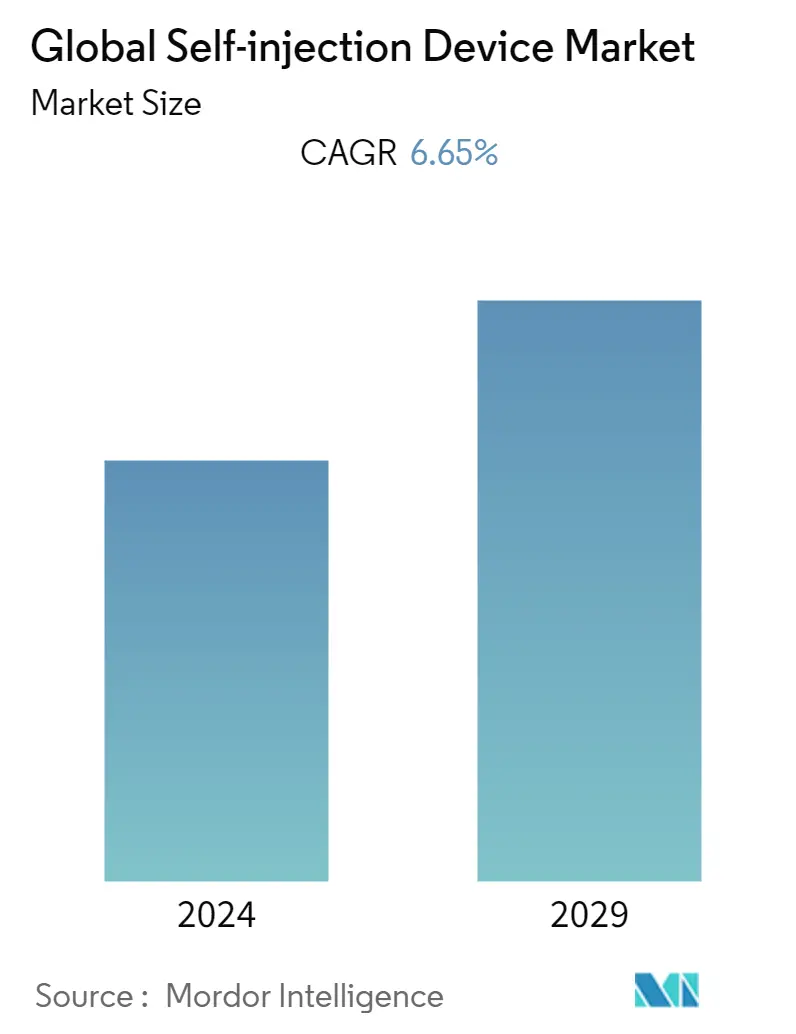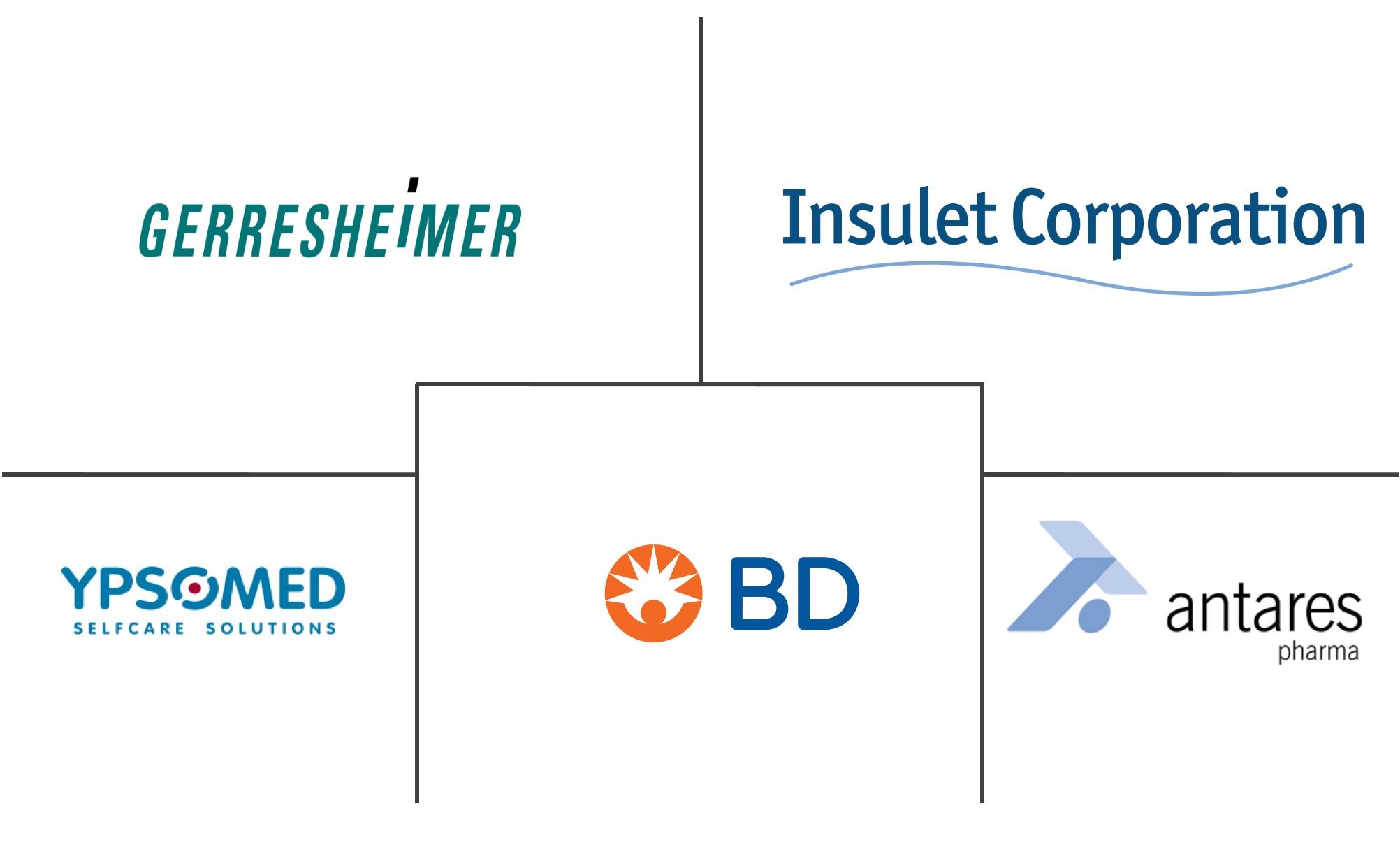Market Size of Global Self-injection Device Industry

| Study Period | 2021 - 2029 |
| Base Year For Estimation | 2023 |
| Forecast Data Period | 2024 - 2029 |
| CAGR | 6.65 % |
| Fastest Growing Market | Asia Pacific |
| Largest Market | North America |
Major Players
*Disclaimer: Major Players sorted in no particular order |
Self-Injection Device Market Analysis
The self-injection devices market is expected to register a CAGR of 6.65% over the forecast period.
The COVID-19 pandemic had an impact on the self-injection devices market as the requirement for self-injectable devices and mass vaccination witnessed a rise since the outbreak of the disease. The threat of getting exposed to COVID-19 had urged patients, particularly those suffering from chronic ailments to opt for self-administration of medication such as self-injection devices at home for easy use. Healthcare professionals kept the healthcare properties free for COVID-19 victims and patients with a need for acute care. This generated the demand for self-injection devices such as wearable injectors. Significantly, the COVID-19 vaccines will increase the demand for injectable devices and the pandemic has also shown the benefit of self-use devices as well as connected devices. Post-pandemic there may be a rise in upcoming innovation in devices and pharma manufacturers will progressively collaborate to use self-injection devices in combination with other digital assets such as apps, phones, and personal computers. Eventually, this will bring the patient into far greater control of their care.
The major factors boosting the growth of the self-injection devices market are the growing prevalence of chronic diseases and the benefits that lead to a rise in demand for self-injection.
Self-injection devices allow patients with chronic diseases to gain control of their treatment schedule and their treatment setting, thus allowing greater independence and freedom in their social, domestic, and professional lives. Self-injection may also offer psychological benefits over administration by healthcare professionals, including improved self-esteem. Removing the need to attend a clinic or hospital for regular injections also brings economic benefits to both the patient and the healthcare system. This economic benefit has been the major growth-driving factor for this market.
Major chronic diseases such as cancer, cardiovascular diseases, chronic lung disease, stroke, Alzheimer's, diabetes, and chronic kidney disease are on the rise all over the world, has also helped the growth as self-injections have applications in recovery from these illnesses. Cancer is a leading cause of death all around the world, accounting for around 10 million deaths in 2020. According to the GLOBOCAN 2020 report, the total number of people in the world affected by cancer in 2020 accounts for around 19,292,789 cases. The number is estimated to rise to 28,887,940 cases by 2040. The increasing prevalence of chronic diseases is expected to add to the market growth, owing to the increase in drug delivery applications.
The recent product launches by major key market players are also adding to the growth of the studied market. For instance, in September 2022, Owen Mumford Pharmaceutical Services launched its new Aidaptus auto-injector platform that has a patient-centric design with automatic needle insertion that provides a simple and consistent user experience. Moreover, in October 2021, Ypsomed introduced the world's first autoinjector with integrated connectivity. It connects the SmartPilot, a networked reusable attachment to the YpsoMate autoinjector for incorporating the auto-injector into a digital therapy management system.Such activities are likely to add to the growth of the market over the forecast period.
However, stringent regulations for approval from regulatory authorities and a lack of awareness of such devices in developing and underdeveloped economies have been restraining the growth of this market.
Self-Injection Device Industry Segmentation
As per the scope of the report, self-injection devices are injections or wearable devices that can be used by the patient in a home setting to administer the medication himself. The Self-injection Device market is segmented by Product (Pen Injectors, Autoinjectors, Wearable Injectors, Needle-Free Injectors), Usage (Disposable and Reusable), Application (Cancer, Auto Immune Diseases, Hormonal Disorders, Pain Management, and Others), and Geography (North America, Europe, Asia-Pacific, Middle East and Africa, and South America). The Market report also covers the estimated market sizes and trends of 17 countries across major regions globally. The report offers the value in USD (US Dollar) million for the above segments.
| By Product | |
| Pen Injectors | |
| Autoinjectors | |
| Wearable Injectors | |
| Needle-Free Injectors |
| By Usage | |
| Disposable | |
| Reusable |
| By Application | |
| Cancer | |
| Auto Immune Diseases | |
| Hormonal Disorders | |
| Pain Management | |
| Others |
| Geography | ||||||||
| ||||||||
| ||||||||
| ||||||||
| ||||||||
|
Global Self-injection Device Market Size Summary
The self-injection device market is poised for significant growth, driven by the increasing prevalence of chronic diseases and the rising demand for self-administration of medications. The COVID-19 pandemic has accelerated the adoption of these devices, as patients sought to avoid healthcare settings and manage their treatments at home. This shift has highlighted the benefits of self-injection devices, such as wearable injectors, which offer greater control and convenience for patients. The integration of these devices with digital assets like apps and smartphones is expected to further enhance patient engagement and autonomy in managing their health. The market is also witnessing innovation, with new product launches and collaborations between pharmaceutical manufacturers and technology companies, aiming to improve the user experience and expand the applications of self-injection devices.
The market's expansion is supported by the growing incidence of chronic conditions such as diabetes, cancer, and cardiovascular diseases, which necessitate regular medication administration. Self-injection devices, including pen injectors, are becoming increasingly popular as they offer economic and psychological benefits, reducing the need for frequent hospital visits. North America is anticipated to hold a significant market share due to its high prevalence of chronic diseases and a supportive regulatory environment. The competitive landscape is characterized by the presence of major players like Becton, Dickinson and Company, Insulet Corporation, and Ypsomed AG, who are actively involved in research and development to enhance device capabilities. Despite challenges such as stringent regulatory requirements and limited awareness in some regions, the market is expected to grow steadily, driven by technological advancements and increasing adoption of self-injection devices.
Global Self-injection Device Market Size - Table of Contents
-
1. MARKET DYNAMICS
-
1.1 Market Overview
-
1.2 Market Drivers
-
1.2.1 Growing Burden Of Chronic Diseases
-
1.2.2 Benefits And Convenience Leading To Increased Demand For Self Injectors
-
-
1.3 Market Restraints
-
1.3.1 Stringent Regulations for Approval
-
1.3.2 Growing Use Of Alternative Delivery Methods
-
-
1.4 Porter's Five Force Analysis
-
1.4.1 Threat of New Entrants
-
1.4.2 Bargaining Power of Buyers/Consumers
-
1.4.3 Bargaining Power of Suppliers
-
1.4.4 Threat of Substitute Products
-
1.4.5 Intensity of Competitive Rivalry
-
-
-
2. MARKET SEGMENTATION (Market Size by Value - in USD Millions)
-
2.1 By Product
-
2.1.1 Pen Injectors
-
2.1.2 Autoinjectors
-
2.1.3 Wearable Injectors
-
2.1.4 Needle-Free Injectors
-
-
2.2 By Usage
-
2.2.1 Disposable
-
2.2.2 Reusable
-
-
2.3 By Application
-
2.3.1 Cancer
-
2.3.2 Auto Immune Diseases
-
2.3.3 Hormonal Disorders
-
2.3.4 Pain Management
-
2.3.5 Others
-
-
2.4 Geography
-
2.4.1 North America
-
2.4.1.1 United States
-
2.4.1.2 Canada
-
2.4.1.3 Mexico
-
-
2.4.2 Europe
-
2.4.2.1 Germany
-
2.4.2.2 United Kingdom
-
2.4.2.3 France
-
2.4.2.4 Italy
-
2.4.2.5 Spain
-
2.4.2.6 Rest of Europe
-
-
2.4.3 Asia Pacific
-
2.4.3.1 China
-
2.4.3.2 Japan
-
2.4.3.3 India
-
2.4.3.4 Australia
-
2.4.3.5 South Korea
-
2.4.3.6 Rest of Asia-Pacific
-
-
2.4.4 Middle East and Africa
-
2.4.4.1 GCC
-
2.4.4.2 South Africa
-
2.4.4.3 Rest of Middle East and Africa
-
-
2.4.5 South America
-
2.4.5.1 Brazil
-
2.4.5.2 Argentina
-
2.4.5.3 Rest of South America
-
-
-
Global Self-injection Device Market Size FAQs
What is the current Global Self-injection Device Market size?
The Global Self-injection Device Market is projected to register a CAGR of 6.65% during the forecast period (2024-2029)
Who are the key players in Global Self-injection Device Market?
Becton, Dickinson and Company, Insulet Corporation, Ypsomed AG, Gerresheimer AG and Halozyme (Antares Pharma Inc) are the major companies operating in the Global Self-injection Device Market.

